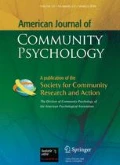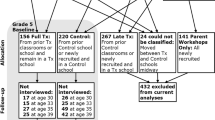Abstract
Described an intervention program designed to prepare elementary school (K-8) eighth-grade students for their transition to high school the following year. Participants in the study were 145, predominantly Hispanic, inner-city public school adolescents. The experimental group received an augmented condition, consisting of Education and Peer Support Components. The control group received a minimal condition consisting of only the Education Component. While no group effects were observed, time effects indicated experimental and control students' improved perceptions of school readiness, but deteriorated perceptions of support from both home and school and diminished grade-point averages and attendance. Time effects also revealed variable changes in school perceptions. Findings are discussed in terms of a developmental perspective of the school transition process. Implications for high school transition programming with the target population and directions for future research are also addressed.
Similar content being viewed by others
References
Alvidrez, J. & Weinstein, R. S. (1993). The nature of “schooling” in school transitions: A critical reexamination.Prevention in Human Services, 10, 7–26.
Bandura, A. (1986).Social foundations of thought and action: A social cognitive theory. Englewood Cliffs, NJ: Prentice-Hall.
Berndt, T. J. & Savin-Williams, R. (1993). Peer relations and friendships. In P. Tolan & B. Cohler (Eds.),Handbook of clinical research and practice with adolescents. New York: Wiley.
Blechman, E. A. (1990). Effective communication: Enabling multi-problem families to changes. In P. A. Cowan & E. M. Hetherington (Eds.).,Family transactions (pp. 219–246). Hillsdale, NJ: Erlbaum.
Blechman, E. A. (1992). Mentors for high-risk minority youth: From effective communication to bicultural competence.Journal of Clinical Child Psychology, 21, 160–169.
Board of Education, City of Chicago (1991),1989–1990 Test scores and selected school characteristics. Chicago: Author.
Bock, R. D. (1975).Multivariate statistical methods in behavioral research. New York: McGraw-Hill.
Brown, G. W., Harris, T. O. & Bifulco, A. (1986). The long term effects of early loss of parent. In M. Rutter, C. E. Izard, & P. B. Read (Eds.),Depression in young people. New York: Guilford.
Cauce, A. M. (1989).Social Support Rating Scale Revised. Unpublished manuscript.
Cauce, A. M., Felner, R. D. & Primavera J. (1982). Social support in high-risk adolescents: Structural components and adaptive impact.American Journal of Community Psychology, 10, 417–428.
Cauce, A. M. & Srebnik, D. (1989). Peer social networks and social support: A focus for preventive efforts. In L. A. Bond & B. Compas (Eds.),Primary Prevention in the Schools. Newbury Park, CA: Sage.
Coie, J. D. (1985). Fitting social skills intervention to the target group. In B. Schneider K. H. Rubin, & J. E. Ledingham (Eds.),Children's peer relations: Issues in assessment and intervention (pp. 141–156). New York: Springer-Verlag.
Cowen, E. L., Lotyczewski, B. S. & Weissberg, R. P. (1984). Risk and resource indicators and their relationship to young children's school adjustment.American Journal of Community Psychology, 12, 353–367.
Crockett, L. J., Petersen, A. G., Graber, J. A., Schulenberg, J. E. & Ebata, A. (1989). School transitions and adjustment during early adolescence.Journal of Early Adolescence, 9, 181–210.
Dodge, K. A. (1983). Behavioral antecedents of peer social status.Child Development, 54, 1386–1399.
Durlak, J. A. & Jason, L. A. (1984). Preventive programs for school-aged children and adolescents. In M. C. Roberts & L. Peterson (Eds.)Prevention of problems in childhood: Psychological research and applications (pp. 103–132). New York: Wiley.
Eccles, J. S., Lord, S. & Midgley, C. (1991). What are we doing to early adolescents? The impact of educational contexts on early adolescents.American Journal of Education, 89, 521–542.
Eccles, J. S. & Midgley, C. (1989). Stage-environment fit: Developmentally appropriate classrooms for young adolescents. In R. E. Ames & C. Ames (Eds.),Research on motivation in education (Vol. 3). New York: Academic Press.
Eccles, J. S. & Midgley, C. (1990). Changes in academic motivation and self-perception during early adolescence. In R. Montemayor G. R. Adams, & T. P. Gullotta (Eds.),Advances in adolescent development: An annual book series: Vol. 2. From childhood to adolescence: A transitional period? (pp. 134–155) New York: Sage.
Eccles, J. S., Midgley, C. & Adler, T. F. (1984). Grade-related changes in the school environment: Effects on achivement motivation. In J. G. Nicholls (Ed.),The development of achievement motivation (Vol. 3, pp. 283–331). Greenwich, CT: JAI.
Eccles, J. S., Midgley, C., Wigfield, W. D., Buchanan, C. M., Reuman, D., Flanagan, C. & MacIver, D. (1993). Development during adolescence: The impact of stage environment fit on young adolescents' experiences in schools and in families.American Psychologist, 48, 90–101.
Elias, M. J. & Clabby, J. F. (1989).Social decision-making skills: A curriculum guide for the elementary grades. Rockville, MD: Aspen.
Elias, M. J., Gara, M. & Ubriaco, M. (1985). Sources of stress and support in children's transition to middle school: An empirical analysis. Special Issue: Childhood vulnerability: Families and life stress: II.Journal of Clinical Child Psychology, 14, 112–118.
Felner, R. & Adan, A. (1988). The school transitional environment project: An ecological intervention and evaluation. In R. Price, E. Cowen, R. Lorion, & J. Ramos-McKay (Eds.),Fourteen ounces of prevention: A cosebook for practitioners (pp. 111–122). Washington, DC: American Psychological Association.
Felner, R. D., Farber, S. S. & Primavera, J. (1980). Children of divorce, stressful life events and transitions: A framework for preventive efforts. In R. H. Price R. F. Ketterer, B. C. Bader, & J. Monahan (Eds.),Prevention in mental health (pp. 81–108). Beverly Hills: Sage.
Felner, R. D., Ginter, M. & Cauce, A. M. (1981). The impact of school transitions: A focus for preventive efforts.American Journal of Community Psychology, 9, 449–459.
Felner, R. D., Ginter, M. & Primavera, J. (1982). Primary prevention during school transitions: Social support and environmental structure.American Journal of Community Psychology, 10, 277–290.
Frith, S. & Narikawa, O. (1970).Attitude toward school: Grades K-12. Los Angeles: Instructional Objectives Exchange.
Harter, S. (1988). Self-esteem and self-concept. In T. D. Yawkey & J. E. Johnson (Eds.),Intergrative processes and socialization: Early to middle childhood. Hillsdale, NJ: Erlbaum.
Hawkins, J. D. & Weiss, J. G. (1985). The social developmental model: An integrated approach to delinquency prevention.Journal of Primary Prevention, 6, 71–97.
Holland, J. V., Kaplan, D. & Davis, S. (1974). Inter-school transfers: A mental health challenge.Journal of School Health, 44, 74–79.
Jason, L. A., Weine, A. M., Johnson, J. H., Warren-Sohlberg, L., Filipelli, L. A., Turner, E. Y. & Lardon, C. (1992).Helping transfer students: Strategies for educational and social readjustment. San Francisco: Jossey-Bass.
King, R. H. (1978),The labor market consequences of dropping out of high school. Columbus: Center for Human Resource Research, Ohio State University.
Larsen, P. & Shertzer, B. (1987). The high school dropout: Everybody's problems?School Counselor, 35, 163–169.
Levin, M. (1972).The costs of the national of inadequate education. Report to the Select Committee on Equal Education Opportunity of the U.S. Senate. Washington, DC: U.S. Goverment Printing Office.
Lloyd, D. N. (1978). Prediction of school failure from third grade data.Educational and Psychological Measurement, 38, 1193–1200.
MacIver, D. (1990). Meeting the needs of young adolescents: Advisory groups, interdisciplinary teaching teams, and school transition programs.Phi Delta Kappan, 71, 458–464.
Maughan, B. & Rutter, M. (1986). Black pupils' progress in secondary schools II: Examination attainments.British Journal of Developmental Psychology, 4, 19–29.
Midgley, C. & Feldhaufer, H. (1987). Students' and teachers' decision-making fit before and after the transition to junior high school.Journal of Early Adolescence, 7, 225–241.
Moore, D. (1985).The bottom line: Chicago's failing schools and how to save them. Chicago, IL: Author.
O'Brien, S. F. & Bierman, K. L. (1988). Conceptions and perceived influence of peer groups: Interviews with preadolescents and adolescents.Child Development, 59, 1360–1365.
Reyes, O. & Hedeker, D. (1993). Identifying high-risk students in a high school dropout prevention program.Prevention in Human Services, 10, 137–150.
Reyes, O. & Jason, L. A. (1991). An evaluation of a high school dropout prevention program.Journal of Community Psychology, 19, 221–230.
Reyes, O. & Jason, L. A. (1993). Pilot study examining factors associated with academic success for Hispanic high school students.Journal of Youth and Adolescence, 22, 57–71.
Reyes, O., Simons, K., & Kobus, K. (1993).Facilitating high school transition for urban youth: The Elementary School Transition Pilot Project. Paper presented at the Division 27 Program of the 1993 Midwestern Psychological Association Conference, April 29–May 1.
Rhodes, J. E., Reyes, O. & Jason, L. A. (1993). Prevention of behavior disorders in children. In R. Morris, & T. Kratochwill (Eds.),Handbook of psychotherapy with children. New York: Pergamon.
Roderick, M. (in press). School transitions and school dropout. In K. Wong (Ed.),Advances in educational policy. Greenwich, CT: JAI.
Rumberger, R. W. (1987). High school dropouts: A review of issues and evidence.Review of Educational Research, 87, 101–121.
Rutter, M. D. (19779). Protective factors in children's responses to stress and disadvantage. In M. W. Kent & J. Rolf (Eds.),Primary prevention of psychopathology, Vol. 3: Social competence in children (pp. 49–74). Hanover, NH: University Press of New England.
Rutter, M. D. (1987). Psychosocial resilience and protective mechanisms.American Journal of Orthopsychiatry, 57, 316–331.
Rutter, M. D., Cox, A., Tupling, C., Berger, M. & Yule, W. (1975). Attainment and adjustment in two geographical areas: III. Some factors accounting for area differences.British Journal of Psychiatry, 126, 493–509.
Schinke, S. P., & Bebel, M. Y. (1989).Coping with junior high: A manual for stress management and preventive intervention, Unpublished manuscript.
Simmons, R. G. & Blyth, D. A. (1987).Moving into adolescence: The impact of pubertal change and school context. Hawthorne, NY: Aldine De Gruyter.
Simmons, R. G., Black, A. & Zhou, Y. (1991). African-American versus white children and the transition into junior high school.American Journal of Education, 99, 481–520.
Sloan, V. J., Jason, L. A. & Bogat, G. A. (1984). A comparison of orientation methods for elementary school transfer children.Child Study Journal, 14, 47–60.
Steinberg, L., Blinde, P. L. & Chan, K. S. (1984). Dropping out among language minority youth.Review of Educational Research, 54, 113–132.
Tidwell, R. (1988). Dropouts speak out: Qualitative data on early school departures.Adolescence, 23, 939–954.
U.S. Department of Health, Education, and Welfare. (1975).Dropout prevention. Washington, DC: Author (ERIC Document Reproduction Service, No. ED 105 354)
U.S. Department of Labor, Bureau of Labor Statistics. (1983).Handbook of labor statistics (Bulletin No. 2175). Washington, DC: Author.
Velez, W. (1989). High school attrition among Hispanic and non-Hispanic white youths.Sociology of Education, 62, 119–133.
Wagenaar, T. C. (1987). What do we know about dropping out of high school?Research in Sociology of Education and Socialization, 7, 161–190.
Werner, E. E., Bierman, J. M. & French, F. E. (1971).The children of Kauai: A longitudinal study from the prenatal period to age ten. Honolulu: University of Hawaii Press.
Werner, E. E. & Smith, R. S. (1977).Kauai's children come of age. Honolulu: University of Hawaii Press.
Winer, B. J. (1971).Statistical principles in experimental design (2nd ed.). New York: McGraw-Hill.
Author information
Authors and Affiliations
Rights and permissions
About this article
Cite this article
Reyes, O., Gillock, K. & Kobus, K. A longitudinal study of school adjustment in urban, minority adolescents: Effects of a high school transition program. Am J Commun Psychol 22, 341–369 (1994). https://doi.org/10.1007/BF02506870
Issue Date:
DOI: https://doi.org/10.1007/BF02506870




